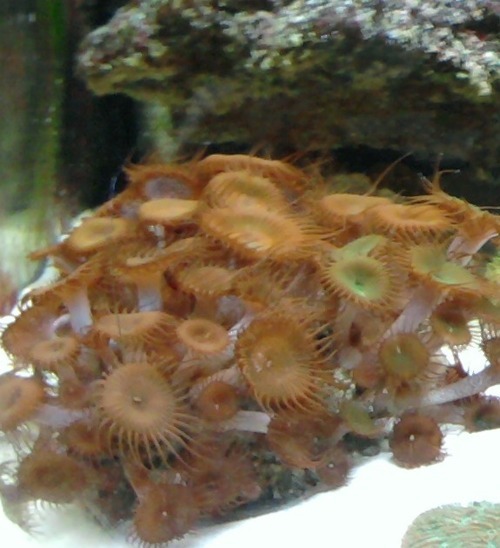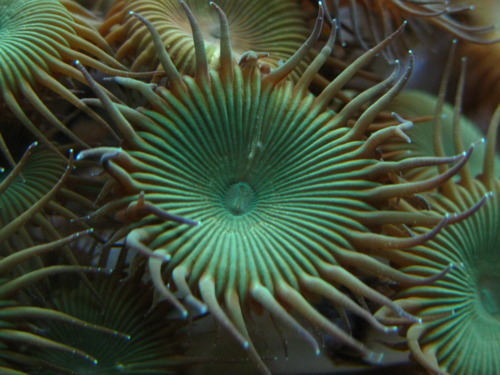
Very hardy. Easy care. Potential first coral for your new aquarium.
Protopalythoa are members of the Zoanthidae family. The look a little bit like zoanthids, only larger.
Feeding: Coral polyps are big eaters and fun to feed (see video). They can eat large pieces of seafood that falls on them. They will eat just about any marine based food you can think of. They will eat, flake food, brine shrimp, shrimp from the grocery store, just about any kind of fish you can cut up before you cook it for dinner and any of the whole assortment of frozen and liquid meaty foods you find at the live fish store. It’s best if the food sinks though. It’d say watching them eat is the best part of owning these polyps. You can even entertain guests who will be surprised at their ability to eat stuff. They move quickly for a coral too.
Lighting: Button Polyps are shallow water coral that like bright daylight spectrum light but because they are such good eaters, they can tolerate medium lighting. Their color may be affected by the lighting. They do well under high concentrations of T5 or power compact lighting but may require some acclimation if you have metal halides. If they are closed or pale, they may have too much light.
Water Flow: Water flow is important in bringing nutrients to this coral
Placement: Place the rock they are attached to in a tight spot so that new polyps will grow on adjacent rocks.
Propagation: Button polyps are an excellent candidate for propagation. Like all good eating corals, they can be made to multiply rapidly, if you desire, through regular feedings of meaty meals. They can be separated from the mother colony with some prying to get them off of the rock. Sometimes the pressure needed to remove the polyps can harm them but most survive intact. Button polyps are slimy and cannot be glued. Place them in a dish of rubble and let them attach themselves to the pieces. Share these corals with friends or bring them to the local frag swap. The only downside is that many others will have them.
Aggression: like all Zoanthidae, button polyps compete for space by chemical warfare. Just keep some space between them and other corals and you should be fine.
Other Information:
*****Warning****
Some zoanthidae contain palytoxin, a chemical that can cause serious illness or DEATH if you get trace quantities on your lips, eyes, or in a cut. Hawaiians used to use this toxin as a weapon of war. Be sure to wash hands after touching them. Dry your wet hands on a paper towel before heading to the sink and dispose of that paper towel immediately. Zoanthidae can also be fatal if eaten by other pets.
*****Warning****


nickthejam liked this
aquaticcastle-blog-blog posted this
